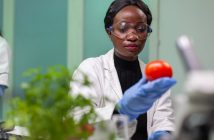Food scientist Souha Guenoun writes about how edible food packaging is paving the road to a sustainable future. Cover: Edible food packing by Evoware
It is amazing that food preservation has no time barrier, knowing how to preserve food has been essential throughout our history as human beings; it helped us survive by not only extending our food’s shelf life but also by enabling the preservation of healthy food.
Today, thousands of years later, food packaging is just as essential as it was, if not more; consumers’ demands have increased causing the market to enlarge its products. If one walks into any supermarket in any country, one can easily find an assortment of food products made locally or imported from other countries, all of this made possible thanks in part to the packaging.
So, while we enjoy the benefits of this plastic packaging, we don’t fully realize the amount of engineering that goes into the multilayered structures, nor the amount of energy required to produce it, only so it can be used for a few weeks max.
Then what happens to it? It certainly does not magically disappear the minute we throw it away. It is estimated that 150 million metric tons of plastics currently linger in the world’s oceans -with more than 60% coming from plastic packaging – [1] for up to 400 years [2] after we’ve used it, causing everything around it to disappear before it, as it disintegrates ever so slowly. The solution to this dilemma might be in innovating the way we produce food packaging.
But, before we jump into packaging innovation, we have to understand first what makes a packaging?
In theory, the designer has to only select some materials from a wide variety to construct a container, easy, right? Except it isn’t. Scientists have to take into considerations a lot of parameters like nutritional value, physical/chemical/microbiological changes caused by temperatures, moisture, oxygen, mechanical effects during shipment, health and safety, cost-effectiveness, new technologies, consumer habits, marketing, legislation, distribution trends, and last but certainly not least environmental impacts, etc. [3]
As plastic packaging has crept gradually into our lives, replacing metal, paper, and glass containers, critics about it have risen, calling out its harmfulness to the environment. Even though recycling plants are established globally, only 14 percent of the plastic is recycled. [4] And smaller chunks of plastic will never make it through a recycling plant, they are too small to fit in; not to mention that whilst recycling plastic packaging requires less energy than making a new one, it still isn’t as green as it should be; in order for packaging to be recycled: water, energy and the transport of materials are all needed to give the plastic a second life.
For that reason, the current trend in food packaging development is that, wherever possible, it should not only be natural and ‘environmentally friendly’, but also functional and cost-effective. [5]
So What Is Edible Food Packaging?
Edible films and coatings may be arbitrarily defined as thin layers of material that can be eaten by the consumer as part of the whole food product. [6] When a packaging like a film, a sheet, a thin layer or a coating is an integral part of a food and is eaten with it, then it is qualified as “edible packaging” [7]
It is a biopolymer designed to contain and protect the food from spoilage and to have the ability to biodegrade like the food it contains. As food components, edible films and coatings usually have to be as tasteless as possible in order not to be detected during the consumption of the edible-packaged food product. When edible films and coatings have a significant or particular taste and flavor, their sensorial characteristics have to be compatible with those of the food.
Read also: Healing the Planet: 6 European Companies Working on Plastic Alternatives
Types of Edible Packaging
First, let’s explain what biopolymers are: they are polymeric biomolecules, in other words, they are large structures made from small units linked together and produced by living organisms, like proteins, DNA, etc.
There are two types of edible packaging, films, and coatings. The difference between the two is that films are first formed separately and then applied to the food product, while coatings are formed and applied directly to the food. They can be superficial coatings or layers between compartments of the same food product.
Polysaccharides, proteins, and lipids are biopolymers used to fabricate edible films or coatings as packaging. While the polysaccharide (starch and derivatives, gums, etc.) and proteins (gelatin, gluten, etc.) offer edible films with satisfactory mechanical and optical properties, they are hypersensitive when it comes to moisture [8] which constitutes a crucial issue in the food industry since the moisture content can cause rapid deterioration of the food.
Contrarily, films composed of lipids (waxes, lipids or derivatives) provide good water vapor barrier properties, yet they are non-transparent, inflexible and prone to rancidity. [8]
The Technology of Edible Packaging
As food components, edible films and coatings usually have to be as tasteless as possible in order not to be detected during the consumption of the edible-packaged food product. When edible films and coatings have a significant or particular taste and flavor, their sensorial characteristics have to be compatible with those of the food.
And since components of edible packaging (proteins, lipids, etc) show shortcomings when used individually, the edible packaging is usually formed with several components in order to combine each component’s complementary functional properties and to reduce their disadvantages. [6]
Usually, the creation of edible films and coatings that serve as edible packaging is done after solubilization, dispersion, or emulsification of a film-forming polymer in a solvent (water, ethanol, organic acid, etc.); which is then applied directly on food or support with the evaporation of the solvent. [7]
Challenges
In reality, edible packaging is not as new as some think it is, research about it is being conducted for decades now. Yet, there’s the problem of human nature; some people presume that since their packaging would disappear in nature, throwing it anywhere is normal. The United Nations noted in a report, “Labelling a product as biodegradable may be seen as a technical fix that removes responsibility from the individual, resulting in a reluctance to take action.” [9]
And then there is also the issue of consumers being reluctant to eat their cutlery or their food wrapping. What’s more is that they can be skeptical about the sanitary part of the edible packaging, whether it protects the food from contamination as regular packaging does.
Another downside is that some non-edible overwrappings are usually still required when edible films or coatings are used (for hygienic reasons). In addition, edible packaging is more sensitive to different environments and requires careful treatment during storage and shipping.
Although, edible packaging might have a long way to go before becoming the norm rather than the exception; it represents a far better sustainable alternative to single-use food packaging.
Need to hire a packaging expert? Consult biopolymer researchers and packaging experts on Kolabtree.
Sources:
- https://cen.acs.org/articles/94/i41/cost-plastic-packaging.html
- https://archive.epa.gov/epawaste/conserve/smm/wastewise/web/html/factoid.html
- https://onlinelibrary.wiley.com/doi/abs/10.1002/%28SICI%291099-1522%28200001/02%2913%3A1%3C29%3A%3AAID-PTS489%3E3.0.CO%3B2-R
- https://www.ellenmacarthurfoundation.org/publications/the-new-plastics-economy-rethinking-the-future-of-plastics-catalysing-action
- https://www.newfoodmagazine.com/article/215/edible-biodegradable-packaging-for-food
- https://onlinelibrary.wiley.com/doi/abs/10.1002/pts.2770080607
- https://www.tandfonline.com/doi/abs/10.1080/10408699891274219
- https://link.springer.com/chapter/10.1007/978-1-4615-2173-0_9
- https://www.unenvironment.org/news-and-stories/press-release/biodegradable-plastics-are-not-answer-reducing-marine-litter-says-un







